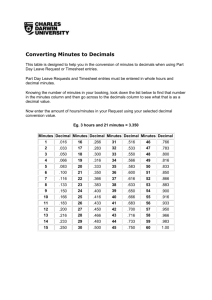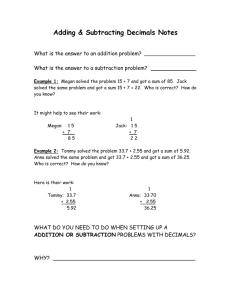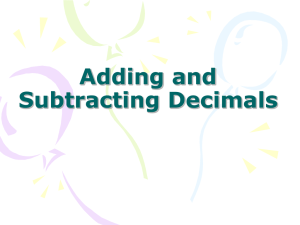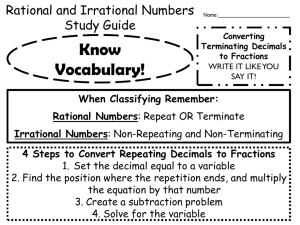22 Arithmetic Operations on Decimals
advertisement
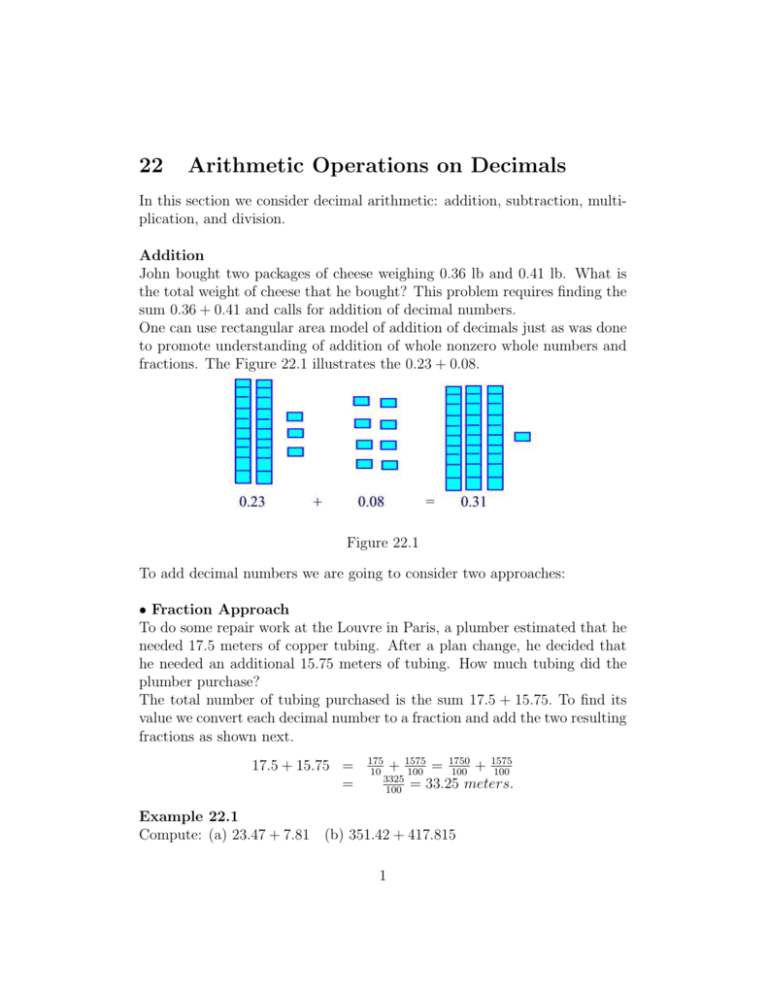
22 Arithmetic Operations on Decimals In this section we consider decimal arithmetic: addition, subtraction, multiplication, and division. Addition John bought two packages of cheese weighing 0.36 lb and 0.41 lb. What is the total weight of cheese that he bought? This problem requires finding the sum 0.36 + 0.41 and calls for addition of decimal numbers. One can use rectangular area model of addition of decimals just as was done to promote understanding of addition of whole nonzero whole numbers and fractions. The Figure 22.1 illustrates the 0.23 + 0.08. Figure 22.1 To add decimal numbers we are going to consider two approaches: • Fraction Approach To do some repair work at the Louvre in Paris, a plumber estimated that he needed 17.5 meters of copper tubing. After a plan change, he decided that he needed an additional 15.75 meters of tubing. How much tubing did the plumber purchase? The total number of tubing purchased is the sum 17.5 + 15.75. To find its value we convert each decimal number to a fraction and add the two resulting fractions as shown next. 17.5 + 15.75 = = 175 + 1575 = 1750 + 1575 10 100 100 100 3325 = 33.25 meters. 100 Example 22.1 Compute: (a) 23.47 + 7.81 (b) 351.42 + 417.815 1 Solution. (a) Converting to fractions and then adding to obtain 2347 100 3128 = 100 23.47 + 7.81 = = + 781 100 31.28 (b) 351.42 + 417.815 = = = 35142 + 417815 100 1000 351420 + 417815 1000 1000 769,235 = 769.235 1000 • By Hand Approach To add decimals by hand, write the numbers in vertical style lining up the decimal points and then add essentially just as we add whole numbers. We illustrate this in the next example. Example 22.2 Compute, by hand, the sum 0.00094 + 80.183. Solution. 0.00094 + 80.183 80.18394 Subtraction of Decimal Numbers Pete find a CD for $16.42 at one store and for $16.98 at another store. He wants to know the difference in price. This situation calls for subtraction of decimal numbers. The techniques used for addition works as well for subtraction. Example 22.3 Compute: 16.98 − 16.42 Solution. Fraction Approach: 16.98 − 16.42 = = 2 1698 − 1642 100 100 56 = 0.56 100 By Hand Approach: 16.98 16.42 0.56 Practice Problems Problem 22.1 Perform the following by hand. (a) 32.174 + 371.5 (b) 0.057 + 1.08 (c) 371.5 − 32.174 (d) 1.08 − 0.057 Problem 22.2 Use rectangular area model to represent the sum 0.18 + 0.24 Problem 22.3 Use a rectangular area model to illustrate the difference 0.4 − 0.3 Problem 22.4 A stock’s price dropped from 63.28 per share to 27.45. What was the loss on a single share of the stock? Problem 22.5 Make the sum of every row, column, and diagonal the same. 8.2 3.7 5.5 9.1 2.8 Problem 22.6 Find the next three decimal numbers in each of the following arithmetic sequences. (a) 0.9, 1.8, 2.7, 3.6, 4.5 (b) 0.3, 0.5, 0.7, 0.9, 1.1 (c) 0.2, 1.5, 2.8, 4.1, 5.4 3 Problem 22.7 Perform the following operations by hand. (a) 38.52 + 9.251 (b) 534.51 − 48.67 Problem 22.8 Change the decimals in the previous exercise to fractions, perform the computations, and express the answers as decimals. Multiplication of Decimals Tom Swift wanted to try out his new Ferrari on a straight stretch of highway. If he drove at 91.7 miles per hour for 15 minutes, how far did he go? Since 15 minutes equals 0.25 hours and distance traveled equals rate times elapsed time, Tom traveled (91.7).(0.25) miles. For a more explicit answer, we need to be able to multiply decimals. One can use rectangular area model of multiplication of decimals just as was done to promote understanding of multiplication of whole nonzero whole numbers and fractions. The Figure 22.2 illustrates the product 2.3 × 3.2. Figure 22.2 The same two approaches that were used for addition and subtraction of decimals can be used for multiplication of decimals. Example 22.4 Compute (91.7) · (0.25). 4 Solution. Fraction Approach: (91.7) · (0.25) = = 25 917 · 100 10 22,925 = 22.925 1000 By Hand: 91.7 × 0.25 4585 1834 22.925 The algorithm of multiplying decimals by hand can be stated as follows: If there are m digits to the right of the decimal point in one number and n digits after the decimal point of a second number, multiply the two numbers, ignoring the decimals, and then place the decimal point in the product so that there are m + n digits after the decimal point. Note that with decimal multiplication we do not need to align the decimal points as we do with addition and subtraction since multiplication of fractions does not require common denominator. Division of Decimals Suppose you fly your own plane. If you traveled 537.6 miles in 2.56 hours, how fast did you travel? Again, since distance traveled equals rate times elapsed time, then rate equals distance traveled divided by time. Therefore, we need to compute 537.6 ÷ 2.56. This requires division of decimals. Example 22.5 Show that 5.376 ÷ 2.56 = 53.76 ÷ 25.6 = 537.6 ÷ 256 = 5376 ÷ 2560. 5 Solution. 53.76 10 5.376 ÷ 2.56 = ÷ 53.76 10 = · 537.6 10 · 537.6 ÷ 256 = 5376 10 5376 10 = ÷ · ÷ 256 10 10 256 = 10 25.6 537.6 10 = 53.76 ÷ 25.6 = = 25.6 10 2560 10 10 2560 5376 ÷ 2560 = It follows that one can move the decimal points of the divident and the divisor the same number of digits to the right without affecting the original division. This leads to the following algorithm: Move the decimal points as much as necessary so that the divisor becomes a whole number. In this case, the division can be handled as with whole numbers division with the decimal point placed directly over the decimal point of the dividend. We illustrate this algorithm in the next example. Example 22.6 Compute 537.6 ÷ 2.56. Solution. Example 22.7 Compute 0.32 ÷ 1.2032. 6 Solution. Practice Problems Problem 22.9 Perform the following multiplications and divisions by hand. (a) (37.1) · (4.7) (b) (3.71) · (0.47) (c) 138.33 ÷ 5.3 (d) 1.3833 ÷ 0.53 Problem 22.10 Kristina bought pairs of gloves as Christmas presents for three of her best friends. If the gloves cost $9.72 a pair, how much did she spend for these presents? Problem 22.11 Yolanda also bought identical pairs of gloves for each of her four best friends. If her total bill was $44.92, how much did each pair of gloves cost? Problem 22.12 Show how to compute 2 × 0.18 using a rectangular area model. Problem 22.13 The product 34.56 × 6.2 has the digits 214272. Explain how to place the decimal point by counting decimal places. Problem 22.14 A runner burns about 0.12 calorie per minute per kilogram of body mass. How many calories does a 60-kg runner burn in a 10-minute run? 7 Problem 22.15 A fifth grader says 50 × 4.44 is the same as 0.50 × 444 which is 222. Is this right? Problem 22.16 A fifth grader says 0.2 × 0.3 = 0.6 (a) Why do you think the child did the problem this way? (b) What would you tell the child? Problem 22.17 Show how to work out 0.6 ÷ 3 with rectangular area model. Problem 22.18 What do you multiply both numbers with to change 6.4 ÷ 0.32 to 640 ÷ 32.? Problem 22.19 Which of the following are equal? (a) 8 ÷ 0.23 (b) 800 ÷ 0.0023 (c) 80 ÷ 2.3 (d) 0.8 ÷ 0.023 (e) 80 ÷ 0.023 Problem 22.20 A sixth grader divides 16 by 3 and gets 5.1 (a) How did the child obtain this answer? (b) What concept doesn’t the child understand? Problem 22.21 Find the next three decimal numbers in the following geometric sequence: 1, 0.5, 0.25, 0.125 Problem 22.22 Perform the following operations using the algorithms of this section. (a) 5.23 × 0.034 (b) 8.272 ÷ 1.76 Problem 22.23 Mentally determine which of the following division problems have the same quotient. (a) 1680 ÷ 56 (b) 0.168 ÷ 0.056 (c) 0.168 ÷ 0.56 Problem 22.24 Perform the following calculations. (a) 2.16 × 31 (b) 2 15 × 1.55 (c) 16.4 ÷ 94 . 8 Problem 22.25 We have seen that if the prime factorization of the numerator and the denominator of a fraction contains only 2s and 5s then the decimal representation is a terminating one. For example, 52 = 0.4. On the other hand, if the prime factorization have prime factors other than 2 and 5 then the decimal representation is nonterminating and repeating one. For example, 13 = 0.3. Write each of the following using a bar over the repetend. (a) 0.7777 · · · (b) 0.47121212 · · · (c) 0.35 (d) 0.45315961596 · · · Problem 22.26 Write out the first 12 decimal places of each of the following. (a) 0.3174 (b) 0.3174 (c) 0.3174 Problem 22.27 If a decimal number is nonterminating and repeating then one can rewrite it as a fraction. To see this, let x = 0.34. Then 100x = 34 + 0.34. That is, 34 100x = 34 + x or 99x = 34. Hence, x = 99 . Use the above approach to express each of the following as a fraction in simplest form. (a) 0.16 (b) 0.387 (c) 0.725 9


